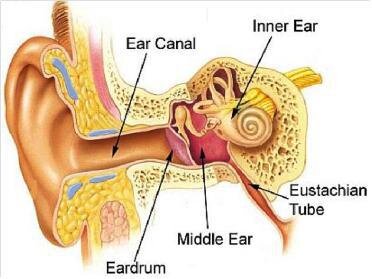Eustachian Tube Problems
Anatomy and Function
The Eustachian tube connects the air space behind the ear drum to the back of the nose.
It opens to allow air to pass into and out of the middle ear and equalize the pressure with the outside world.
Eustachian tube problems may cause:
Ear pressure or pain
Problems popping the ears
Severe ear pain or pressure when flying or scuba diving
Fluid behind the ear drum
Repeated ear infections
Medical Treatments
The following are steps you can take to help decrease the pressure in your ears and to pop them open. This will minimize pain or problems in your ears when you fly on a plane, travel up or down a mountain or dive deep in the water.
The best prevention is to maintain your ears and nose as healthy as possible, using regularly any medications or sprays which your Beach Cities ENTS doctor has prescribed for these problems.
The common medical treatments include:
1. SALINE SPRAYS. You can use saline washings numerous times (3-5x) each day until your ears have popped and feel normal. Point the spray in all different directions in your nose and then, blow it out. You cannot use this too much.
2. NASAL STEROID SPRAYS. These sprays decrease swelling in your nose and your Eustachian tubes to help them pop open. Nasal steroid sprays must be used everyday to be effective and often take 5-7 days before you will notice their benefit. They only work on the areas they touch. To use them properly, point the spray toward the same eye or ear as the side of the nose you spray. Spray 2 puffs into each nostril once a day everyday until your doctor instructs you to stop, even if you feel better. You can sniff in the medicine but do not need to inhale it. These sprays should not burn or cause bleeding and if they do, please stop and notify your Beach Cities ENTS doctor.
3. NASAL DECONGESTANT SPRAYS. Over-the counter topical nasal decongestant sprays will help open up your nose and ears. Spray it in your nose twice in each nostril 3 times a day each day for 2-3 days only. Use of these sprays for longer than 2-3 days can lead to addiction and complications.
4. DECONGESTANT PILLS. Purchase an over-the-counter decongestant and take it for one week as directed to open up your nose and ears.
5. HIGH BLOOD PRESSURE WARNING. If you have high blood pressure, check with your internist prior to taking decongestant sprays or pills. Both of these medications can increase your blood pressure.
6. ORAL STEROIDS. In severe cases, your Beach Cities ENTS doctor may prescribe oral steroids to give you rapid and dramatic reduction in swelling. The scares and concerns about steroids usually refer to long-term usage, not 1-2 weeks. Nevertheless in some patients, oral steroids can cause stomach upset, worsen ulcers, diabetes or high blood pressure, and some people report mood changes such as euphoria, anxiety or depression. If you have any problems while on the medicine, please call your doctor.
7. EXERCISES. There are exercises, which you can perform to help push air into your eustachian tubes and open them up. The better you can equalize the pressure in your eustachian tubes or sinuses, the less pain you will have and the faster you will return to normal. You can perform these exercises as often as you like, but definitely as you descend in the plane or down the mountain or at least 2 times each day until your ears are better. Perform these exercises sitting or standing (not lying down).
The exercises will initially cause a sound like crackling or Rice Krispies in your ear which identifies that air is slowly getting back behind your eardrum. This is good and a sign of improvement. Eventually, your ear will pop and the clogged feeling will disappear. Then, your hearing should return to normal.
a) Chew gum. Drink liquids. Any activity that forces you to swallow will help decrease pressure.
b) Yawn. Open your mouth wide.
c) Irrigate with the saline spray and blow your nose.
d) Blow up a balloon and let the air out and repeat this 10 times. Pinch your nose closed between your thumb and index finger. Keep your mouth closed tight. Blow out against your closed nose and mouth to force air into your ears. Do not blow so hard that it causes you pain or dizziness.
Surgical Treatments
Eustachian Tube problems that do not improve with medications can be treated with surgery.
There are 2 surgeries that are available:
1. Myringotomy with placement of Ear Tubes is the most common ear operation.
Myringotomy is an incision in the eardrum. Middle ear fluid and infected material can be suctioned from the middle ear through this opening. When it is necessary to maintain the opening longer, a tube can inserted into the opening. These tubes do not correct the Eustachian tube itself but bypass the problem and provide another way to release pressure.
Most tubes will stay in the eardrum and maintain the opening for 6 to 24 months, and then come out of the eardrum spontaneously. If the problems remain, the tube needs to be replaced. Hearing is often dramatically improved immediately after the procedure.
2. Eustachian Tube Balloonplasty
Eustachian Tube Balloonplasty is an innovative, safe and effective procedure to treat Eustachian tube dysfunction.
Eustachian Tubeplasty or Balloon Dilation attempts to restore normal function to the Eustachian tube with the goal of eliminating the need for repeated ear ventilation tubes.
The procedure is FDA approved in adults 22 years and older.
It is performed in an operating room under general anesthesia.
No pre-operative blood testing is typically required for most patients.
Using a surgical telescope in the nose, a balloon dilation catheter is inserted through the nose and passed into the Eustachian tube. The balloon is inflated to stretch the Eustachian tube and then deflated and removed.

